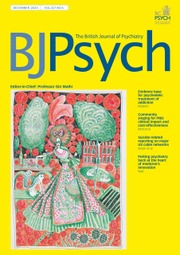Large language models (LLMs) are neural networks that use billions of parameters pre-trained on large-scale language corpora.Reference Thirunavukarasu, Ting, Elangovan, Gutierrez, Tan and Ting1 Emergent capabilities are thought to arise within LLMs as the scale of training parameters and data increases.Reference Zoph, Raffel, Schuurmans, Yogatama, Zhou and Metzler2 One notable example is the zero-shot reasoning capability of LLMs, which refers to their ability to perform specific tasks based on text instructions without any task examples or extra fine-tuning. Although LLMs are known to encode clinical knowledge comparable with that of human clinicians even without additional training,Reference Katz, Cohen, Shachar, Somer, Fink and Morse3–Reference Habib, Butt, Goldenholz, Chang and Goldenholz5 the extent to which recent LLMs can be safely adopted in the field of psychiatry remains underexplored.
In February 2024, we evaluated five LLMs (GPT-4, LLaMA2-70B, Mixtral-45B, Vicuna-13B and Gemma-7B) using a zero-shot approach, each repeated five times (Supplementary Table 1). These models were tasked with diagnosing 21 clinical cases and answering 95 multiple-choice questions drawn from the DSM-5-TR® Clinical CasesReference Warren Barnhill6 and DSM-5-TR® Self-Exam Questions.Reference Muskin, Dickerman, Drysdale, Holderness and Maalobeeka7 The performance of the LLMs was compared with that of 11 psychiatry residents from a tertiary hospital. Residents were then retested on the questions where their initial answers differed from those of the best-performing LLM (GPT-4), with the LLM's answers provided for reference. All procedures involving human subjects were approved by the Institutional Review Board of Severance Hospital (4-2024-0131).
GPT-4 notably outperformed both psychiatry residents and open-source models in diagnostic and knowledge tasks (Fig 1). For instance, in diagnostic tasks, GPT-4 achieved a mean F1 score of 63.41%, markedly higher than the residents’ score of 47.43% (P = 0.005). Similarly, in knowledge tasks, GPT-4 demonstrated an accuracy of 85.05%, compared with the residents’ accuracy of 62.01% (P = 0.002). Notably, when residents received guidance from GPT-4, their performance improved, with mean F1 scores in diagnostic tasks increasing to 60.15% (P < 0.001) and accuracy in knowledge tasks rising to 81.63% (P < 0.001).

Fig. 1 Bar plots of the task performances using mean scores and error bars with 95% confidence intervals. Dashed vertical lines separate the task performance of the residents (left) and the large language models (right). Asterisks indicate a significant (P < 0.05) difference compared with GPT-4 results from the Mann–Whitney U-test.
However, GPT-4 was not without flaws. It exhibited a higher rate of ‘comorbidity errors’ where mutually exclusive diagnoses (e.g. major depressive disorder and bipolar I disorder) were simultaneously presented, compared with the residents (30.48% v. 0.87%, P < 0.001). The process of making psychiatric diagnoses in humans is influenced by psychiatrists’ understanding and belief systems, shaped by art, politics, philosophy, religion, psychotherapies and personal experiences. The high comorbidity error rate of GPT-4 suggests that its diagnoses lack this blend of unique experiences and interpretations, ultimately affecting its diagnostic results. For instance, GPT-4 often provided adjustment disorder as the main diagnosis alongside major depressive disorder, acute stress disorder, post-traumatic stress disorder and prolonged grief disorder (Supplementary Table 2). This phenomenon is consistent with findings of other studies, which have reported that LLMs frequently struggle to understand the context of specific patient cases or grasp subtle differences between individual disorders.Reference Balas, Wadden, Hébert, Mathison, Warren and Seavilleklein8 Despite this, the comorbidity error rates of the residents did not increase significantly after GPT-4 guidance (P = 0.4405; Table 1 and Supplementary Tables 3 and 4), suggesting that GPT-4 can positively influence clinicians’ decision-making without increasing critical errors.
Table 1 Performance, similarity to GPT-4, and comorbidity error rate of residents before and after GPT-4 guidance

a Calculated using paired t-test.
The significant increase in similarity between residents’ answers and GPT-4's responses after the guidance (mean Jaccard index rising from 0.26 to 0.42 in diagnostic tasks; P < 0.001) raises important considerations about the integration of LLMs into psychiatric practice. Prior research has highlighted that dependence on clinical decision-aiding algorithms could impair medical professionals’ critical thinking.Reference Gaube, Suresh, Raue, Merritt, Berkowitz and Lermer9 There is more to consider in psychiatry than the DSM, and uncritical acceptance of these tools may potentially affect patient outcomes. Therefore, careful integration into practice is necessary.
It is important to note that in this study, LLMs were assigned the role of ‘expert’, which may have obscured the comparison, as the human group consisted of residents still in training. Future research could use a ‘psychiatry resident’ role for LLMs, compare LLMs with board-certified psychiatrists and use prompts that include the multifaceted knowledge of the DSM, ICD and psychodynamic psychiatry.
As the field of psychiatry continues to evolve, it is crucial to approach the integration of LLMs thoughtfully. Although they offer promising capabilities, maintaining the human element in psychiatric care – including the ability to interpret complex patient narratives and contextualise symptoms within broader life experiences – remains paramount. Balancing technological advances with the irreplaceable aspects of human clinical expertise will be key to leveraging LLMs effectively in psychiatric practice.
Supplementary material
Supplementary material is available online at https://doi.org/10.1192/bjp.2024.207
Funding
This study received no specific grant from any funding agency, commercial or not-for-profit sectors. S.C.Y. serves as the chief technology officer of PHI Digital Healthcare and received grants from Daiichi Sankyo.
Declaration of interest
The authors declare no conflicts of interest.






eLetters
No eLetters have been published for this article.